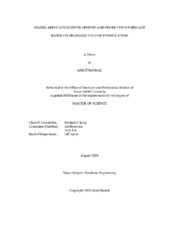| dc.description.abstract | Unconventional resources have recently gained significant momentum in the industry while the scientific understanding of these resources are primarily under research. Due to the large scale of activities with hundreds of wells drilled, significant optimization to improve efficiency is carried out by Data driven technologies. These resources require detailed understanding like hydraulic fracturing, horizontal drilling in order to understand the productivity of a well.
To understand the complex fracture geometry, we develop the asymptotic solution of the diffusivity equation. This work builds on the research by Zhenzhen Wang (Wang, 2018) and Andrew Malone (Malone, King, & Wang, 2019), and implements the time evolution of the w(τ) function, which characterizes the flow geometry of the transient drainage volume. It allows us to identify linear flow, onset of fracture interference, matrix permeability, fracture half length, fracture surface area and the volume of SRV. A software (SPADES) was developed on a Python-Excel platform. The application uses Python based scientific libraries and an Excel bases user-interface to calculate the diagnostic plots. The application implements Outlier and Noise removal algorithm, and also automates the tuning parameters.
Production forecast based on the transient solution of the drainage volume formulation and is an analytical solution based on the reservoir properties. Reservoir properties like matrix permeability, fracture half length, hydraulic diffusivity is determined from the w(τ) function. The forecast is based on an elliptical drainage model where the w(τ) function extrapolated up to the expected reservoir volume. This technique may be used to forecast the pressure–production performance, EUR, UR and productivity index. We demonstrate the technique on a finite element simulator and an Eagle Ford well using a production rate history match and flowing material balance. Further, sensitivity analysis is performed to understand the parameters affecting this analytic technique.
The SPADES application may be used by Exploration & Production companies to understand the behaviour of their wells and select refracturing candidates, while the production forecast can be a reliable source of forecast for reserve booking and economic analysis. | en |


